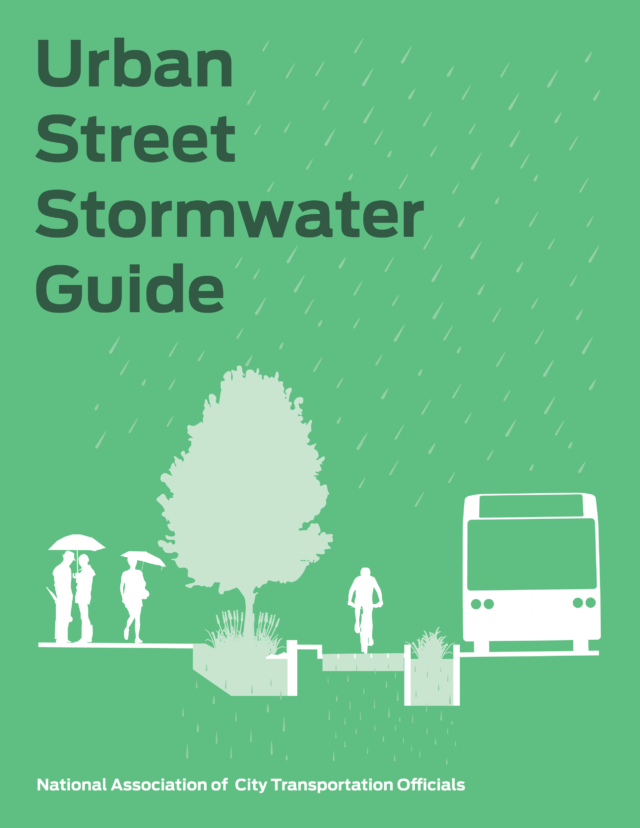A first-of-its-kind collaboration between city transportation, public works, and water departments
 For Immediate Release:
For Immediate Release:
June 29, 2017
Press Contact:
Alexander Engel
[email protected] | 646.324.2919
View the Guide online >
Purchase from Island Press >
Streets make up more than 80 percent of all public space in cities and their design can support—or degrade—the overall health of an urban area. Excess asphalt contributes to stormwater runoff, which can carry pollutants into water bodies and overwhelm sewer systems. As more and more cities reclaim street space for human life and habitat and enact far-reaching plans to address climate change, there is need for guidance on how to integrate valuable ecological processes into urban streets.
Building on their successful series of street design guides, NACTO’s Urban Street Stormwater Guide provides practitioners, leaders, and other advocates with the tools to design streets for successful stormwater management. It shows how Green Stormwater Infrastructure (GSI) can bolster strategies to provide a safe and pleasant walking and biking experience, and safer streets for all users.
Developed through a first-of-its-kind collaboration between city transportation, public works, and water departments, and thanks to the generous support of the Summit Foundation, the Urban Street Stormwater Guide provides design guidance based on innovative strategies tested on the ground in cities nationwide.
Example case studies include roadside rain gardens in Seattle, WA; green transitways in Minneapolis, MN; multi-way boulevards in Nashville, TN; stormwater greenways in Los Angeles, CA; permeable pavers in Atlanta, GA; and citywide green infrastructure planning in New York, NY. Topics addressed include regional climate and ecology; bioretention design considerations; street design, character and use; zoning; collaboration and partnerships; and performance measures.
“Too often we’ve learned the hard way that the water always wins,” observed Darryl Young, Director of Sustainable Cities at the Summit Foundation. “This guide sets out a bold vision for how cities can work with water, not against it. It is a blueprint for how to create safe, complete streets that view stormwater as a resource to be integrated into the natural fabric of the cities we want.”
From bioswales in the bikeway buffer zone to using street trees to improve the experience waiting at a transit stop, the Urban Street Stormwater Guide is a collection of creative, proven innovations for incorporating GSI into the right of way. The guide will help cities manage stormwater and reap the public health, environmental, and aesthetic benefits of street trees, planters, and greenery in the public realm, while enabling cities to build safer streets for everyone.
####
About the National Association of City Transportation Officials (NACTO)
NACTO is an association of over 50 major North American cities formed to exchange transportation ideas, insights, and practices and cooperatively approach national transportation issues. The organization’s mission is to build cities as places for people, with safe, sustainable, accessible, and equitable transportation choices that support a strong economy and vibrant quality of life.
Island Press
Founded in 1984, Island Press works to stimulate, shape, and communicate the information that is essential for solving environmental problems. Today, with more than 1,000 titles in print and some 30 new releases each year, it is the nation’s leading publisher of books on environmental issues.